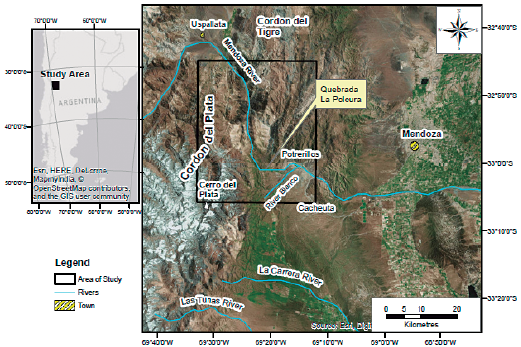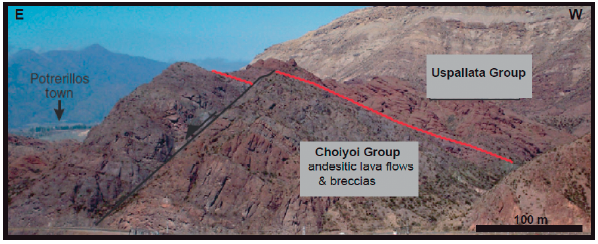Introduction
The basement of the central Andes of Argentina is largely constituted by an assemblage of rhyolites, andesite, mesosilicic igneous complexes and interbedded volcanic breccias and tuffs of Late Permian - Middle Triassic age. These rocks have been included within the Choiyoi Group (Choiyoi), which covers an area of at least 200,000 km2 and may be up to 500,000 km2 in central - western Argentina and Chile (Llambias et al. 2003). In general, the base of the unit is characterised by rocks of mafic to intermediate composition whilst, the upper members are dominated by felsic volcanites, including rhyolites. In Argentina, the sequence is exposed across several geologic provinces, from the Neuquén basin in the south (~ 39° S) to the Andes of Mendoza and San Juan (i.e. Principal and Frontal Cordillera), at an approximate latitude of 30° South. Due to its widespread extension, the Choiyoi has been related to the magmatism that occurred during the breakdown of the western margins of Gondwana in the Late Palaeozoic (Zeil, 1981; Ramos. 1999; Rocha-Campos et al. 2011). More specifically, the volcanism appears related to large-scale faults associated to anisotropy in the upper crust (Giambiagi and Martinez, 2008). As the backbone of the Andes of southern South America and being one of the most important geological units of Argentina, the Choiyoi has been extensively studied over the years (e.g. Gonzalez Diaz, 1957; Stipanicic et al. 1968; Ramos et al. 1988; Gregori and Benedini, 2013; Sato et al. 2015; Spalletti and Limarino, 2017; and many others.). Despite the large amount of work that has been done, the large geographical extent, lithological diversity and complex structural setting, means that a clear understanding of the origin and evolution of the Choiyoi is still elusive. Furthermore, most papers about the unit deal with its facies distribution and lithological features, but only a few examine the geochemical, chronological and tectonic aspects of the unit (Strazzere et al. 2006). In this regard, the present work integrates petrography, geochemistry and structural data from an area where the magmatism is well represented, in order to better recognise the geologic features of the Choiyoi in central Argentina and to help constrain its tectonic evolution along the southwestern margins of Gondwana. The study is focussed on the northeast of the Cordón del Plata range (Cordón del Plata), in the Frontal Cordillera of Mendoza, Argentina. In here, the basement is represented by a variety of rocks and structures that reflect the evolution of the unit through different Andean cycles. Even though the paper provides an overview of the geology in this area, the broader aspects of the rock characteristics as well as the geodynamic processes are expected to be common to other regions and ultimately, have implications for the entire formation.
Location and Regional Setting
The study area is located west of the town of Potrerillos in the Cordón del Plata range, within the margins of the Frontal Cordillera in the central Andes of Argentina. In particular, the site locates between about 32° 45' S and 33° 10' S, on the north-northeast section of a major mountain chain that extends 100 km by 50 km between the Mendoza and Las Tunas Rivers (Figure 1). Morphologically, the ridge includes numerous valleys and peaks with an elevation close to 6,000 m.
The oldest rocks recognised in the area correspond to the Palaeozoic basement, which consists mostly of sedimentary and metamorphic deposits of variable characteristics. The lower member is represented by conglomerates with volcanic clasts, stratified quartzite and litharenites assigned to the Vallecitos Beds, of pre-Carboniferous (Devonian?) age (Figure 2). Near Las Tunas River, the unit is known as the Guarguaraz Complex, which consists of metasedimentary and mafic and ultramafic rocks deformed in the Middle Devonian and later in the early Carboniferous (Lopez de Azarevich et al. 2009; Willner et al. 2011). Further east, in the Precordillera belt, these rocks are partially overlapped by a sequence of Silurian-Devonian turbiditic sandstones intruded by granitoids, commonly referred as the Villavicencio Group (Harrington, 1957). The tectono-sedimentary environment of the unit has been interpreted as a passive continental margin or the continental side of a back-arc system (Kury, 1993).
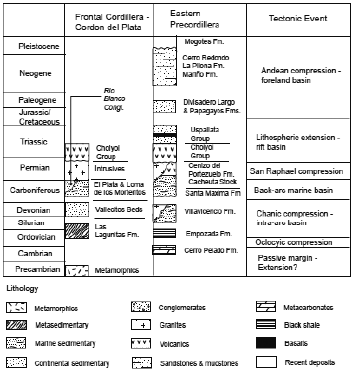
Figure 2 General stratigraphy of the Cordón del Plata and surroundings (modified from Giambiagi et al. 2011).
A hiatus separates the Vallecitos Beds from the Upper Carboniferous strata. In some places this hiatus would correspond to an angular unconformity attributed to the Chanic diastrophism (Furque and Cuerda, 1979). In the Frontal Cordillera of Mendoza, the Upper Carboniferous is largely composed of marine clastic deposits assigned to the El Plata Formation (Fm.) and Loma de los Morteritos Fm. (Caminos, 1965; Rolleri and Criado Roqué, 1969). In particular, these units have been described as a succession of feldspathic litharenites with subordinate litharenites and lithic arkoses, which reflect terrigenous contributions (Spalletti et al. 2011). Simultaneously, the deposition of proximal alluvial fans and glacial debris would be represented by the Rio Blanco Conglomerates, an array of sedimentary and volcanic pebbles from the Upper Carboniferous - Lower Permian.
The Palaeozoic basement is unconformably overlain by volcanics from the Choiyoi Group (Groeber, 1946) and intruded by plutons of Permian -Middle Triassic age (Figure 3).
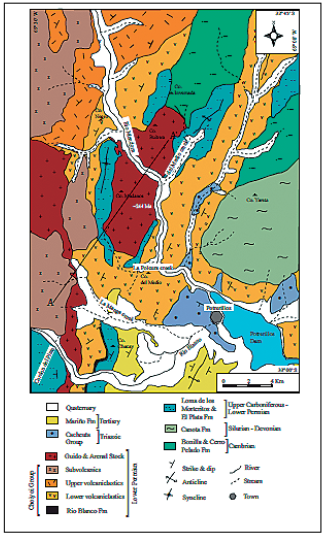
Figure 3 Geological map and sampling of the Cordón del Plata range and southern Precordillera of Mendoza (modified from Martinez, 2005; Strazzere et al. 2016).
More recently, Llambias et al. (2003) and Strazzere et al. (2016) included the Rio Blanco Conglomerates in the Choiyoi Group, as the sedimentary unit was considered transitional to the volcanic rocks above. The Choiyoi outcrops extensively along the Cordón del Plata and neighbour localities such as Cordón del Portillo, Cerro Cantera, and Quebrada de Santa Elena. In general, the lower half of the unit comprises andesitic lavas and breccias, whilst the upper half consists of rhyodacitic and lithic pyroclasts and rhyolite lava-flows (Martinez, 2005).
It is widely accepted that there were at least four major deformation events in the Frontal Cordillera: a) compression related to the Famatinian and Chanic orogeny in the pre - early Carboniferous; b) widespread contraction and crustal thickening known as the San Rafael orogeny in the early Permian; c) extensional tectonics from the Andean Cycle in the Late Permian - Middle Triassic and; d) compression and uplift of the Cordón del Plata in the Cainozoic. In this regard, the Choiyoi in the study area is affected by north - south trending thrusts and strike-slip faults related to stress propagation during the Pangea breakup. Additionally, the elongated geometry of the Triassic granitoids with the same trend of the normal faults indicates that their intrusion could be structurally controlled by these faults (Heredia et al., 2012).
Methods and materials
A field survey was undertaken in the northeast section of the Cordón del Plata to enable a systematic characterisation of the stratigraphy and to identify the most prominent features of the bedrock. Geological mapping, lithological logging and structural measurements were carried out simultaneously to assess stratigraphic relationships and mineralogical variations of the deposits. Fifteen samples of fresh vulcanites and plutonic rocks were additionally collected to determine the main geochemical characteristics of the sequence. The samples were analysed for major and trace elements by X-ray fluorescence spectroscopy (XRF) and inductively coupled plasma-mass spectrometry (ICP-MS) at the laboratories of the University of Cornell, New York and at ACTLABS, Ontario, Canada. The ICP-MS is widely used as a conventional method to determine ultra trace compositions using solutions prepared by digestion of rocks. For more details about the methodology, the reader is referred to Tamura et al. (2015). Similarly, XRF is a well-established analytical technique for geochemical investigations (Young et al. 2016). As described by Potts (1992), samples are prepared as compressed powder pellets or fused glass discs and excited with x-ray radiation. Interaction between this primary radiation and atoms of the sample causes ionization of discrete orbital electrons. During the subsequent electronic rearrangement by which the atom de-excites back to the ground state, fluorescence x-rays of energy characteristic of that element are emitted. The emission intensity of this characteristic radiation is ultimately measured with a suitable x-ray spectrometer and compared with that from a standard sample.
Several other specimens were made into polish thin sections and selected for petrographic analyses at the San Luis University, Argentina. The slides were examined by a polarizing-light microscope and the observations ultimately captured in higher-magnification images. Finally, calculations and plotting of the rock's geochemical data were done using the GCDkit software package from Janousek et al. (2006).
Results
Historically, the composition of the Choiyoi would be increasingly silicic upwards, from mafics near the base to rhyolites and felsic rocks at the top (Polanski, 1958; Llambias et al. 1993; Strazzere et al. 2016).
We defined the Lower Choiyoi in the Cordón del Plata as typically basaltic and andesitic unlike the Upper member, largely composed of dacites, rhyolites and granitic rocks (Table 1). The mafic facies correspond to basalts, andesite and andesitic breccias outcropping in the vicinities of the Cerro Negro ridge. The sequence is separated from the Palaeozoic bedrock by a high angular unconformity. The basalts are typically fractured and cut by subvertical red, rhyolitic dikes up to 350 meters (m) thick, possibly related to the major granitic bodies that intrude all units (Caminos, 1965; Martinez, 2005). The texture of the basalts is predominantly porphyritic, with phenocrysts of plagioclase in a pilotaxitic groundmass (Figure 4). Bands of andesitic breccias of northeast orientation are also present. With a thickness of about 500 m, these greenish-black breccias are highly consolidated, with much of the material consisting of euhedral plagioclase (An50) and hornblende randomly distributed in a consolidated fine-grained paste.
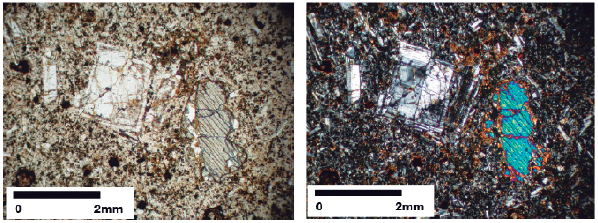
Figure 4 Phenocrysts of plagioclase and pyroxene embedded in a groundmass of plagioclases in the basaltic lava unit.
The felsic volcanic facies of the Choiyoi correspond to a maximum of 800 m of rhyodacitic lavas with numerous outcrops showing columnar disjunction, whilst others are characterised by some flow banding defined by the parallel arrangement of planar minerals. The thickness of the bands seldom exceeds a few centimetres. They are commonly folded and moderately foliated, which indicates a ductile deformation of the lava front during its advance. Generally, the rhyodacitic lavas exhibit a porphyritic texture with euhedral plagioclase (An30) and biotite phenocrysts in a dark brown paste (Figure 5). Mineralogically, the dikes are characterised by a porphyry texture with phenocrysts of plagioclase and biotite embedded in a felsic paste and isolated spherulites of similar composition to the phenocrysts.
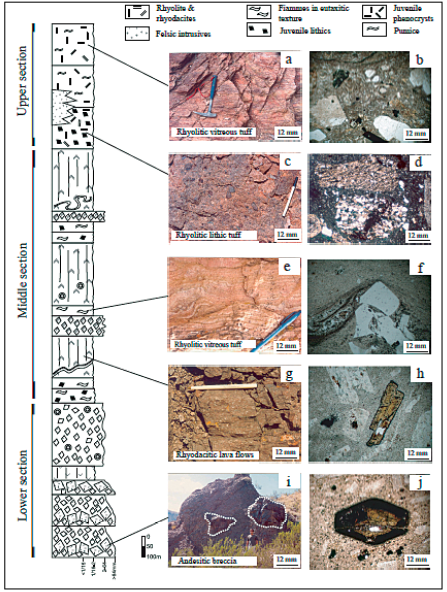
Figure 5 Typical stratigraphic column of the Choiyoi Group. a-b) rhyolitic vitreous tuff with quartz and feldspar with preserved shreds; c-d) rhyolitic lithic tuff with phyllite and sandstone from the pre-volcanic basement; e) rhyolitic vitreous tuff with folding eutaxitic texture; f) phenocrysts of euhedral quartz with deformed vitroclastics; g-h) rhyodacitic lava flows with phenocrysts of biotite and plagioclase in felsitic paste; i) andesitic breccia with block of andesitic lava flows; j) Phenocrysts of euhedral honblende in paste with plagioclase.
A suite of rhyolitic tuffs is interlayered within the sequence. Usually, these tuffs have phenoclasts of quartz, sanidine and plagioclase (An20) into a spherulitic and eutaxitic matrix. Similarities in colour, structure and rock coherence difficult the recognition of facies in the field. Nonetheless, the mineralogical examination reveals at least two distinctive types of tuffs: a) lithic tuffs containing abundant fragments of accidental pelite and phyllites, commonly predominant in the north of the Cordón del Plata; b) multi-coloured pumicitic tuffs enriched in quartz, alkali feldspar and biotite embedded in a glassy paste. These rocks are often amalgamated with light-colour pumice clasts in a highly vesicular matrix. Additionally, some moderately-welded ignimbrites as described by Marshall (1935), outcrop in the region.
The last stage of the Choiyoi magmatism in the region is represented by granitoids whose largest manifestation occurs in the peaks of the Cerro Médanos, south of the Andean Precordillera of Mendoza. These rocks, known as the Guido Stock, have an ellipsoid pattern that cover an area of approximate 60 km2 and forms a mountainous terrane mostly over 2,000 m above sea level (Orme et al. 1996). The granitoids are pink to white, typically composed of coarse-grained quartz, k-feldspar and plagioclase (An16), with minor hornblende and flakes of biotite (Figure 6). Titanite, zircon and some opaques are the main accessory minerals. Near its top, the stock shows a conspicuous dike of basaltic horizons, together with the local development of quartz-biotite hornfels product of the reaction with the host rock during emplacement. The basalts are black, aphanitic, and show an excellent development of columnar disjunction up to 10 m thick. Furthermore, the stock is dissected by numerous reddish hypabyssal rocks predominantly porphyritic, mostly consisting of phenocrysts of quartz, feldspar and plagioclase in a microgranular groundmass.
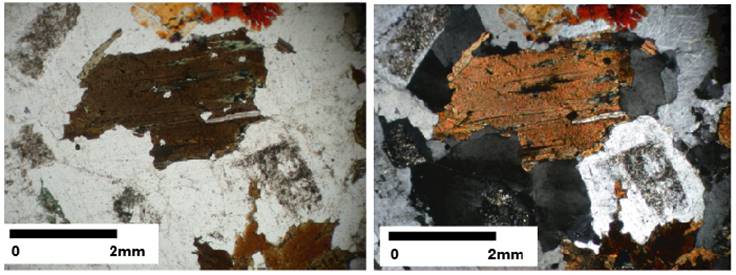
Figure 6 Microphotograpy of the granites showing coarse-grained quartz, k-feldspar and plagioclase with subordinated biotite.
From the tectonic point of view, convergence of the oceanic crust against the Pacific edge of Gondwana resulted in several episodes of deformation during Palaeozoic to Caenozoic times (Ramos, 1988; Giambiagi and Martinez, 2008). In general, the region is characterised by fractures and faults trending west-northwest to north-northeast, associated to a network of minor and discontinuous structures that cross cut the basement in multiple directions. In particular, the Frontal Cordillera can be divided into the structural western and eastern domains, which are separated by the La Carrera fault system, an array of north-south reverse faults active until recent times. The western domain, where the Cordón del Plata locates, is distinguished by east-vergent reverse faults crossed by sinistral strike-slip faults of northwest orientation (Giambiagi et al. 2014).
Chemical composition, and different diagrams can be used to discriminate the origin of the volcanic rocks in the Choiyoi Group (Appendix I). A detailed interpretation of the results is presented in the following sections.
Discussion
Lithological Facies
It is clear that the Choiyoi magmatism resulted in a complex array of volcanic and igneous rocks that partly intercalates with pyroclastic beds, conglomerates and sandstones deposited after tectonic reactivation at a more local scale. Ignimbrites and rhyolitic tuffs are also present in the uppermost part of the sequence (Tobares et al. 2015). In this context, the lowermost part of the Choiyoi Group would represent an intermediate to mafic subduction-related magmatism (Gregori and Benedini, 2013) whilst, the breccias could be the end product of the fracturing and opening of vents at the initial stages of the volcanic eruption. Based on field relationships and lithological similarities, the mafic facies has been correlated to the Portezuelo del Cenizo Fm., outcropping in region of Quebrada del Tigre, north of the study area (Folguera et al. 2001). In addition, K/Ar measurements in an andesite from Quebrada del Tigre suggest that the unit is from the Lower Permian, with an estimated age of 281 ± 10 Ma (Rapalini and Vilas, 1991).
Higher in the sequence, the rhyodacites of the Cordón del Plata appear closely related to the dacites of Pampa de la Canota, which outcrop in the Precordillera region of Mendoza to the north. The dacites registered a K/Ar age of 263 ± 15 Ma and therefore, are attributed to the Middle Permian (Folguera et al. 2001). These deposits, which can be considered part of the vitreous tuffs group, are characterised by pink to orange tonalities, ill-defined bedding and a distinctive eutaxitic texture product of the compaction of glass shards and pumice fragments during the mobilisation of the pyroclastic flow. Poor particle sorting and the absence of clear sedimentary structures suggest that part of the ignimbrites would have been deposited as pyroclastic flows. Thus, the stratified ignimbrites are consistent with an explosive eruption that fragmented the volcanic conduits and incorporated lithic fragments into a density current flow along valleys and topographical depressions. Simultaneously, part of the pumice materials remained in suspension, to be dispersed by the wind and be deposited at lower rates throughout the region. In this energetic regime, the preferential down-current transport of selected clast types produces a decrease in clasts density with distance, from dense bombs in the proximal breccia to low-density pumices and ash in distal ignimbrites (Branney and Kokelaar, 1997).
The ignimbrites of the Cordón del Plata were intruded by felsic dikes with a maximum thickness of 5 m. Their texture is mostly porphyritic, with phenocrysts of plagioclase and biotite in a fine-grained mass. Considering that the dikes present compositional similarities to the host rock, it is argued that the intrusion occurred as part of a residual magma soon after the volcanic eruption. Cortés et al. (1999) presented K/Ar results from biotite minerals in the dikes, which resulted in an age of 241 ± 7 Ma, equivalent to the Olenekian - Anisian in the Triassic.
Finally, the felsic bodies at the top of the sequence are likely related to late pulses of the felsic magma that originated the bulk of the granites in the area. The absence of internal deformation suggests that the intrusions would be post-tectonic, possibly emplaced contemporaneously with the stock solidification (Caminos, 1979; Cingolani et al. 2012). Thus, the stocks' emplacement could be linked to the initial phases of rifting and extensional relaxation along the western margins of Pangea, after the peak in volcanic activity during the Permian - Early Triassic. In this line, isotopic dating also indicated that the Guido Stock could be ascribed to Early - Middle Triassic times. In effect, K/Ar analyses in samples from Cerro Médanos yielded and age of 244 ± 10 Ma (Early Triassic) whilst, rocks at the neighbour Cerro Arenal constrained the magmatism to 237 ± 10 Ma, in the Middle Triassic (Caminos et al. 1979).
Tectonic structures and deformation
As previously mentioned, a regional west-northwest fault zone develops in the area of La Polcura - La Manga. This is also indicated by additional sinistral strike-slip and dip-slip faults longer than 5 km (Figure 7). The La Polcura and La Manga faults are parallel but dip into one another. Thus, they represent a graben-like zone that separates westerly-oriented structures in the Precordillera from north-south faults in the Frontal Cordillera (Giambiagi and Martínez, 2008). The La Carrera fault would have originated during the uplift of the range in the late Cainozoic (Caminos, 1965; Polanski, 1972).
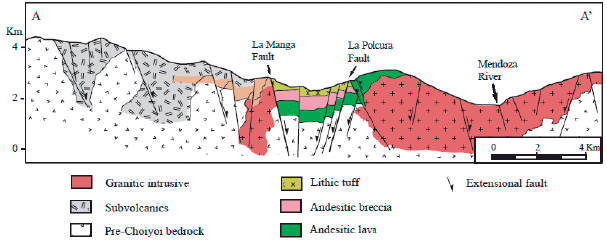
Figure 7 Schematic cross-section A-A' (see Figure 3 for location) showing the graben-like structure delimited by the La Manga and La Polcura faults.
Pre-Choiyoi structures
These structures include thrusts and folds of variable wavelength and amplitude, ranging from a few cm to several km in length. The deformation especially affects the marine deposits from the Upper -Carboniferous to the Early Permian but has no influence over the Choiyoi rocks indicating thus, an Early Permian age (Giambiagi et al. 2011). Rocks of the Early Palaeozoic are characterised by numerous brittle structures somewhat difficult to differentiate from the main Andean synorogenic ones formed after the Miocene. An exception occurs when the structures are unconformably overlain by the Permo - Triassic vulcanites, which act as a diagnostic marker in the tectonic record. To the west, Palaeozoic faults mostly strike north-south to north-northwest, unlike the eastern domain where the prevailing faults' direction is northeast to north-northeast. Similarly, the folds generally trend north-northwest to northeast, with their axial planes dipping either east or west.
As recognised by von Gosen (1995), deposits of the Late Palaeozoic are crosscut by dextral north-northwest structures and sinistral north-northeast strike-slip faults, which cannot be traced into the Permo - Triassic sequence. Mutual crosscutting relationships between opposite dipping faults suggest that these structures would have developed as a conjugate set. Some of the strike-slip faults cut the thrust faults and some do not, but they all predate the Permo - Triassic vulcanites. Therefore, the strike-slip faults seem to be coeval with the late Palaeozoic thrust faults, while others are likely to be genetically related to the Permo - Triassic extension (Giambiagi et al. 2011). Kinematic analyses of the Palaeozoic structures suggest a contractional regime with a west-northwest trending λ3 in the western domain, shifting to a northwest trending λ3 in the east. Although the Permian structures result primarily from orogen-normal contraction, the strike-slip fault systems affecting the belt indicate a left-lateral strike-slip regime associated with a north-south trending λ3 and an east-west trending λ1 (Giambiagi et al. 2011).
Middle Permian - Late Triassic deformation
A widespread contractional episode known as the San Rafael orogeny generated a crustal thickening in the Early Permian (Azcuy and Caminos, 1987). The lower Choiyoi unconformably covers the San Rafael structures indicating thus, that compression ceased before the extrusion of the volcanic rocks. The Middle Permian to Late Triassic represented an extensional period, concomitant with an intense magmatism responsible for the bulk of the vulcanites in the Choiyoi. The peak in volcanic activity took place in the Permian, followed by the development of a continental rift basin during the Triassic.
The Choiyoi rocks, both vulcanites and volcaniclastics, are dissected by normal and oblique-slip normal faults that trend west-northwest to northwest (Figure 8). The great thickness and facies variations of the rocks near these structures, and the relationship between the structures and the intrusion of plutonic rocks suggest that they are syn-magmatic Permo - Triassic (Giambiagi and Martinez, 2008). As previously mentioned, the La Polcura and La Manga faults are two of the most prominent structures from the Permo - Triassic in the region. In particular, the La Polcura fault extends for over 30 km and shows a vertical displacement of at least 500 m. Slickensides on the exposed surface indicate two sets of striae. The older set corresponds to a sinistral oblique-slip normal movement attributed to the reactivation of a strike-slip fault during the Permo - Triassic extension in the Andean Orogeny. In contrast, the younger fault system exhibits a sinistral strike-slip movement ascribed to reactivation during the Andean shortening. The La Manga fault runs approximately in the same direction than La Polcura, to finally merge into a single structure southward. Nonetheless, the tilted blocks of both La Polcura and La Manga dip toward each other to form a regional graben that presumably enabled the emplacement of andesitic breccias and ignimbrites of the middle and upper sections of the Choiyoi Group, respectively.
Fault-slip data from major and mesoscale faults in the Permo - Triassic volcanics (50 m > displacement < 50 m, respectively) indicates a homogeneous orientation of north-northeast maximum stretching direction (Giambiagi and Martínez, 2008). This deformation episode contributed to the evolution of two groups of faults: a) structures of west-northwest to northwest strike, with normal offset and a minor to negligible strike-slip component; b) normal, oblique-slip faults of sinistral offset, typically oriented north-northwest such as the La Manga fault. Even though the major north-northwest, oblique-slip faults could be attributed to the reactivation of Palaeozoic structures during the Andean orogeny, the mesoscale oblique faults were identified exclusively in the Permo - Triassic volcanics. Therefore, it is postulated that both sets of faults are newly created, broadly formed during the complex crust extension that extended from the Permian to the Cretaceous.
Andean deformation
The formation of the Frontal Cordillera can be related to uplift and exhumation of the Palaeozoic and Mesozoic basement during the Andean orogeny. The orogeny initiated in the Principal Cordillera in the Early Miocene, migrating towards the Cordón del Plata in the Late Miocene - Early Pliocene (Giambiagi et al. 2003). As a result of the compression, the Palaeozoic structures were reactivated as reverse faults oriented with respect to the maximum stress propagation. On the other hand, reactivated faults from the Permo - Triassic exhibit a sinistral displacement (Terrizano et al. 2010). In this regard, the La Carrera fault system has traditionally been considered to be part of the process that gave rise to the Cordón del Plata (Caminos, 1965).
Geochemical considerations
Mafic volcanic rocks
Different types of mafic rocks were recognised in the succession, as indicated by the tracers Zr/TiO2 - Nb/Y. In the diagram of Winchester and Floyd (1977), samples plot in the field of an andesite (Figure 9a). As for the dikes, the total alkali versus silica (TAS) relationship (Middlemost, 1994) indicates a gabbroic diorite of subalkalic signature (Figure 9b). In turn, the K2O vs. SiO2 discrimination (Pecerillo and Taylor, 1976), shows that the rocks are predominantly high-K, calc-alkaline volcanics (Figure 9c). This is consistent with Strazzere et al. (2016), who also distinguished three types of volcanic rocks, all K-rich, in the Portezuelo del Cenizo Fm, between the Cordón del Plata and the Frontal Cordillera of Mendoza. Using the more mobile elements Th and Co (Hastie et al. 2007), mafic samples mostly fall in the basalt-andesite field. In contrast, the andesitic calc-alkaline rocks plot in the high-K, shoshonitic category (Figure 9d). In this regard, the whole rock geochemistry of the Choiyoi volcanics suggest a transition from calc-alkaline magmatism at ~266 Ma to more alkaline/shoshonitic compositions at ~248 Ma (Kimbrough et al. 2015). The tectonic discrimination diagram of Schandl and Gorton (2002) shows little scattering for the mafic rocks, with the bulk of the samples reflecting the homogeneous provenance of the rocks, which plots in the active continental-margin field (Figure 9e). Within the generally mobile LILE group, Th is a relatively stable and reliable indicator, whose enrichment relative to other incompatible elements (especially Nb and Ta) is taken to represent the subduction zone component (Wood et al. 1979). In this context, the calc-alkaline basalts of the Choiyoi are part of the destructive plate margins described by Wood (1980) (Figure 9f). The Th/Yb - Ta/Yb binary plot is useful to assess the role of source heterogeneities, metasomatism, and crustal contamination in the generation of magmas (Pearce, 1983). The plot shows that samples are displaced toward higher Th/Yb ratios, which is consistent with rocks from the Central Andes subduction zone (Figure 9g). Low Ta/Yb ratios point to the involvement of a depleted mantle (Ta/Yb< 1), whilst the high Th/ Yb ratio may be attributed to the enrichment of this mantle by a subduction component carrying Th, but not Ta or Yb (Pearce et al. 1990).
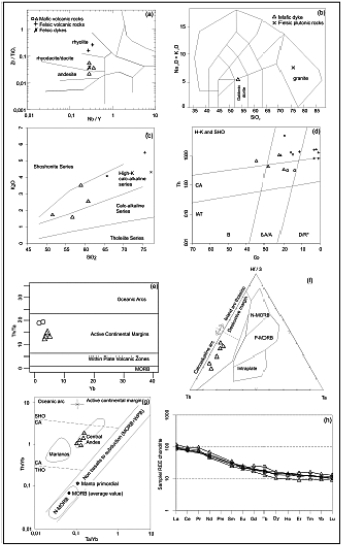
Figure 9 Variation diagrams for geochemical discrimination of the Choiyoi rocks. a) Zr/TiO2 vs. Nb/Y diagram of Winchester and Floyd (1977); b) TAS diagram of Middlemost (1994); c) SiO2 vs. K2O plot of Peccerillo and Taylor (1976); d) Th-Co diagram of Hastie et al (2007); e) Diagram of Schandl and Gorton (2002) for discrimination of felsic to intermediate volcanic rocks; f) Th-Hf-Nb tectonic discrimination of Wood (1980); g) MORB normalized diagram of Pearce (1983); h) chondrite-normalized REE diagram of Nakamura (1974) for mafic rocks.
The mafic rocks are moderately enriched in light rare earth elements (LREE) and have a nearly flat signature in heavy elements (HREE) normalised to chondrite (Figure 9h). As interpreted by Sun et al. (2019), this signature would imply a mantle source in a volcanic arc environment and a convergent plate margin. Thus, the melt would have been generated in the mantle wedge above the subduction zone, possibly representing the initial stages of basaltic volcanism.
Felsic rocks
The felsic rocks are mainly rhyolites and granites, with SiO2 close to 80 % and Na2O + K2O of about 6%. Additionally, the general composition of the unit ranges from high-K rhyolites to shoshonites. All samples exhibit a somewhat flat pattern in the chondrite-normalized REE, with negative Eu anomalies. The Eu anomaly can therefore be used as an indication of the amount of fractionation that magma has undergone (Tobares et al. 2015). A slight Eu depletion was observed in rhyodacite lava flows and rhyolitic tuffs (Figure 10a), unlike the granites that showed a pronounced reduction in the Eu content (Figure 10b). Thus, the overall patterns of the felsic rocks are considered to be the end result of arc magmatism in an average crustal column, with plagioclase fractionation occurring at low pressures (< 1Kbar).

Figure 10 Chondrite-normalized REE plot of Nakamura (1974). a) Choiyoi Group felsic volcanic rocks; b) Choiyoi Group felsic plutonic rocks.
Concluding Remarks
The present work examined the petrography, geochemistry, and structural style of the Choiyoi Group in the Cordón del Plata range of Argentina, to better understand the rocks' physical character and the evolution of the western margins of Gondwana since the Palaeozoic. Three distinct lithologic facies were recognised in the sequence, which becomes increasingly felsic upwards. In this regard, the base of the Choiyoi consists of mafic rocks, mostly basalts, andesite, and andesitic breccias that correlate with the Portezuelo del Cenizo Formation, from the Lower Permian. The second facies includes rhyodacites and minor rhyolitic tuffs attributed to the Middle Permian. These rocks are commonly foliated and folded, likely as a result of continuous compression and surface cooling at the advancing lava. In particular, the tuffs can be subdivided into two main groups: lithic tuffs prevailing in the north, and vitreous tuffs and pumices to the south. The poor stratification, eutaxitic texture and intensity of the welding suggest deposition from a pyroclastic density current, followed by the downfall of lighter pumices and ash. Following the volcanic eruption, the magma triggered many dike injections in the Triassic. The third lithofacies is represented by the granites of the Guido Stock, correlated to the final stages of magmatism in the Early to Middle Triassic. In addition, the pluton displays a wide range of dike swarms and metamorphic contacts either syntectonic or partly brought during subsequent stages of the tectonism. The San Rafael orogeny has been recognised to be responsible for the deformation in the Carboniferous to Middle Permian. Nevertheless, the Choiyoi basement in the Cordón del Plata unconformably overlies the San Rafael structures indicating thus, that volcanism postdates the orogeny. In this regard, the mafic rocks at the bottom of the studied sequence would derive from a primary magma at the base of the continental crust, in a convergent plate margin. The magma ascent would have contributed to thermal maturation and crustal melting and the subsequent generation of felsic tuffs and lava flows. Migration of the magma might have preferentially occurred through reactivated high-angle, oblique-normal faults such as the La Manga - La Polcura system. The magmatic cycle culminated in the Triassic with the emplacement of large granite bodies controlled by extensional structures associated to the breakup of Gondwana.













